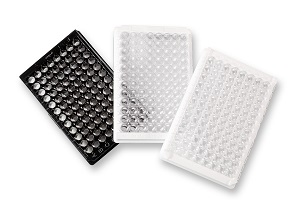Streptavidin- and Neutravidin-Microplates
PolyAn is offering Streptavidin-/Neutravidin-coated microplates that are suitable for immunoassays, DNA hybridization assays, and other demanding bioassays that utilize biotinylated moieties. The Streptavidin- and Neutravidin-coated plates are made using PolyAn’s proprietary Molecular Surface Engineering technology to achieve maximum efficient coating with Streptavidin or Neutravidin.


Biotin-binding Microplates
Key features
- No leaching of Streptavidin and Neutravidin due to covalent immobilization
- Minimal unspecific binding due to 3D-functional matrix
- Ready-to-use: no additional washing or blocking steps required
- Available for colorimetric, chemiluminescence, or fluorescent detection
- Each plate is packaged in a separate foil bag to ensure optimal shelf-life
Benefits of covalent coating
PolyAn’s Streptavidin or Neutravidin matrices are covalently attached to the surface, so that the molecules are less susceptible to desorption in the presence of surfactants, solutions of high ionic strength, or at high temperatures, compared to adsorptive immobilization.
Advantages of Neutravidin
Neutravidin is a de-glycosylated form of avidin. Although Streptavidin is still the most popular and widely used biotin-binding protein, Neutravidin offers several benefits:
- Near-neutral isoelectric point (pI) of 6.3 efficiently decreases non-specific interactions
- De-glycosylation (carbohydrate removal) prevents non-specific binding of lectins
- Lacks the bacterial RYD sequence (Arg-Tyr-Asp) of SAv that causes non-specific binding in cell assays
Neutravidin's high biotin-binding affinity and low non-specific binding make it the ideal biotin-binding protein!
Customized plate surfaces
Please do not hesitate to contact us, if you require a special surface for binding of your biomolecules that is not listed in the products table. Other plate formats and substrates can be equipped with our surfaces as part of our Molecular Surface Engineering Services. We are also happy to support you in developing suitable protocols for coating on our plates.
Additionally, PolyAn offers a range of glass bottom plates in a wide range of surfaces and well designs. PolyAn also equips glass slides and polymer slides with Streptavidin and Neutravidin surfaces as well as solvent stable microplates that are comprised of Polypropylene (PP).
